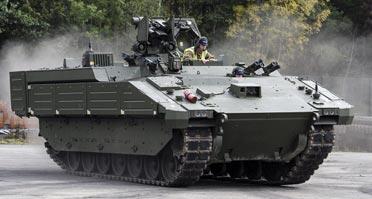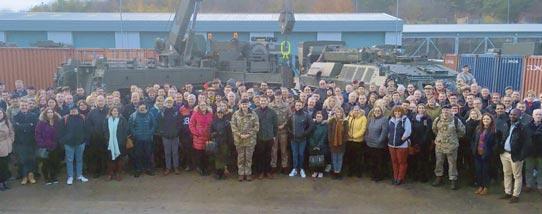
12 minute read
Guest Editorial: Colonel Paul Cummings: VST
Vehicle Support Team (VST)
Intro to VST – Col Paul Cummings – Acting Head VST
Advertisement
The Vehicle Support Team (VST) support nearly all of the current in-service fleet of land platforms. From Quad Bikes to Challenger 2, Foxhound to Bulldog and everything in-between. We are the people behind the platform, managing upgrades, safety, supply chains, technical through life support, as well as repair and deep overhaul; to the tune of around £400M a year. We are a large team, all of whom focus on meeting the needs of the Front-Line Commands (FLCs) and predominantly the Field Army. With a mix of military personnel (from Sgt to WO1 and Capt to Brig) and Civil Servants, numbering around 400 people, some have been with us for over 40 years whilst some arrived only this month! We are made up of many sub-teams, but the largest REME contingents are within Operations and Operations Support and, in this article, we’ll give you a feel for where our REME personnel are, what they do and why they love it.
Colonel Paul Cummings (Deputy Head Vehicle Support Team)
Maj Wayne K Burnard MBE – Operations Team COS
The Operations Team provide ‘best in class’ support to the FLCs; the Royal Navy, the Royal Marines, the British Army, and the Royal Air Force. HQ Field Army under the new Army Operating Model set the activity profile and demand signal to baseline the level of support that the Operations Team must deliver. Our mission is keeping safe, reliable and fit equipment in the hands of the user. The team’s ethos is that no matter what happens we must always support the user as best we can.
The Operations Team is split into 12 sub-teams, which we call Order Book Items (OBIs), focusing on specific platform groups that contain a total of 35 in-service platform types amounting to circa 26,000 platforms. Within each of the OBIs sits the project teams led by an Operations Manager who is supported by functional staff (Commercial Officers, Cost Controllers, Technical Through Life Support personnel, Supply Chain Managers and Engineers) to tackle platform specific issues, such as safety, finance, risk and engineering. The Operations team directly support the platforms in barracks and deployed on exercise & operations.
Next you will read about REME Officers and Artificers who contribute to the Operations Team in various roles. The roles develop SQEP in engineering, safety, risk, finance, supply chain and commercial activities up to Cap & Acq practitioner level. It is challenging and rewarding in equal measure; supporting the platforms no matter what they are being asked to do. The benefits of working in a diverse environment that is a mix of civilian and military personnel are clear, and it is great to see how passionate the civilian staff are in delivering an effect for the user groups they support. My personal experience has been outstanding, I have learnt a lot and it has been a real privilege to be part of this team. Lt Col Tim Turner – Senior Operations Manager
Being a Senior Operations Manager (SOM) is akin to a Command appointment in a Battalion and it certainly has all the benefits and challenges. Supporting the troops is the focus of all teams in DE&S so having military staff officers and Warrant Officers in selected appointments enables that whilst complementing the expertise of our civilian colleagues.
Having been in a SOM role since completing ACSC, I have been managing a portfolio of various armoured vehicles including Warrior, Challenger, CRARRV, Titan and Trojan, I am responsible for their ongoing safety, availability and improvement. Working with my team of 25 Civil Servants and 4 military personnel, I manage a budget of
VST, just some of the Team
c.£40m to ensure the equipment remains safe to use and has all necessary improvements implemented to ensure conformance with contemporary requirements and legislation. This requires collaborative working with major defence firms and close liaison with Army Headquarters and Field Army to ensure the needs of the users are represented. Understanding contractual nuances and exploiting them to ensure major programmes such as CR3 are adequately supported provide the challenge and therefore satisfaction of this busy role. Daily application of hard-won engineering knowledge to make decisions and ensure the vehicles remain safe gives a sense of empowerment and purpose.
Working for me are the Operations Managers (OM), who focus in great detail on one vehicle only, and are the experts for that vehicle. A military OM will typically have completed Sub-Unit Command.
Life as an Operations Manager Maj Ed McCann – Operations Manager
Having joined as the OM for Mastiff and Ridgeback towards the end of the first ROTO of Op NEWCOMBE, I was immediately faced with several challenges. The pace of preparing bespoke Urgent Operational Requirements (UORs) for theatre meant there was no time to work through the Concept, Assessment and Demonstration phases in detail and some issues being encountered in theatre. I therefore deployed to Mali with WO2 (AQMS) Ross Adamson, the Cougar Subject Matter Expert, to investigate. Assessing the fleet, speaking to crews, maintainers, and the operational planning teams, we were able to improve user confidence in the equipment and understand previously unreported issues. For example, while we had understood that tyre degradation in theatre was high, we were unaware that 65% of failure came from sidewall penetration. To overcome this, we were able to adapt an off-the-shelf item already in use with the Swedish Army to provide a solution. Maj Barry Codd – Operations Manager
As the OM for Bulldog, I manage a vehicle which has seen 60 years in service; almost as long as myself! The vintage of the vehicle tends to mean that its management is less (rather than more) predictable; demanding that I juggle a myriad of different tasks and rapidly switching between them. Some recent safety issues on Bulldog include: asbestos, final drives, noise and vibration, mortar firing, crew heaters, peer to peer recovery, mini pipe fascines,
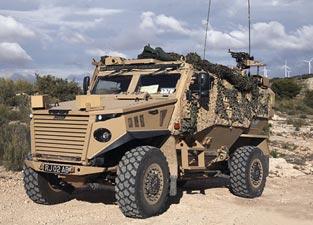
Foxhound, pic supplied by www.Joint-Forces.com
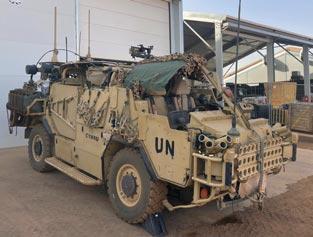
JACKAL
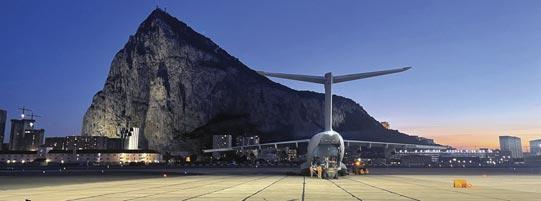
In Gibraltar, A400M being loaded with supplies (Photo taken by Maj Ed McCann)
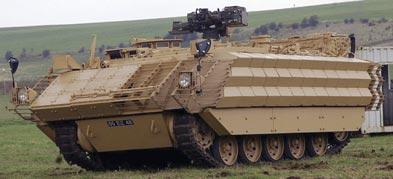
Bulldog
sprocket rings and exhaust extraction. Having a methodical approach to the resolution of safety issues is key to taking a problem from identification, through the issuance of a Safety Notice, to a trialled and endorsed solution issued to the Field Force. The drive and ability to keep equipment in the hands of the user has earned appreciation and praise from CFA; demonstrating the key role that the OMs perform.
Maj Charlotte Hayes – Operations Manager
With previous experience in Cap & Acq, I am now the OM for Pinzgauer and Quad. I work collaboratively with large contractors and ensure they perform well. Reading into the detail of the contracts I manage, and having a full appreciation of the nuances, has enabled me to work collaboratively with the contractors to ensure they hit their milestones, which has paid dividends. This approach helps if/when you need to have tough conversations about performance and potentially withholding payments; all of which is within the remit of an OM.
DE&S takes professional and personal development seriously, and so has developed a pathway for each career stream from Aware, through to Practitioner and onto Expert. I have been able to demonstrate the opportunities available for wider personal development. While managing the REME Women’s Cross-Country teams and competing in the Swimming Teams, I have also gained a MSc in Defence Acquisition Management, a Post-Graduate Diploma in Strategic Leadership, Chartered Engineer and Associate Project Management Professional (APMP) qualifications. Education and personal development has been met with similar success and many of the Warrant Officers are working to achieve degree-level qualifications.
Col Tim Allison – Operations Support Head
Where the Operations Team is structured to manage each platform separately, Operations Support (as the name suggests) support our whole fleet of vehicles with teams of experts. We provide pan-platform support in many specialist areas including: Data Support, Technical Through Life Support, Post-Design Services, Repairs, Supply Chain Management, Scheduling, Cost Control and more. This allows us to apply our expertise across several areas while developing centres of excellence within our teams. The team is ~113 strong with around 90% of the team being Civil Servants with the remainder being military personnel. We also have a thriving ex-military community, from some who left the REME 20 years ago, to one (who you will hear from next) who left last year. There are lots of opportunities to broaden or deepen your KSE in Ops Sp, and to get engaged with some really important pan-platform activity. We are the team that fix the pan-platform issues, take on the ‘brain function’ for VST by improved use of data and expertise, and seek to add value across the entire Vehicle Support Team. Paul Simpson MBE IEng – Post Design Services
Sceptical of the future but full of positivity and optimism, I drew stumps from life as a REME Late Entry officer on the 1st October 2021. With several operational tours under my belt and a broad range of engineering experience, I applied, was successful, and started a role within VST Ops Support as a Post Design Service Operations Manager within the Protected Mobility Engineering Technical Solutions (PMETS) team. The transition from Military service to private sector was somewhat seamless through the Equinox contract, and was certainly no more problematic than moving assignment in my opinion. It was made very easy by my employer knowing the military way of life and what we offer.
I have done a considerable amount of reflection since deciding to leave. Everyone has their reasons, mine was to devote more time to my wife and young family. On starting a new career, initially it felt daunting like any new job. The handover was completed without any face-to-face interaction and was probably what I found most difficult. Moreover, there was no-one sitting beside you to answer the simple questions, particularly when dealing with multi-millionpound contracts when you just want to ‘do the right thing’ and ‘get it right first time’. Post Design Services is a critical role within the Protected Mobility fleet. We are an extremely small team managing a plethora of modification tasks at any one time. My role primarily involves forecasting and planning, keeping tasks on track to meet target dates, while dealing with contractual issues and resolving them quickly, and at the lowest level before escalation. Within the myriad of ongoing tasks, PMETS deal directly with Safety, Routine Modifications and Urgent Operational Requirements across the protected mobility fleet which prioritises them within the resources available to the contractor for completion on time. On more than one occasion, I’ve realised the importance of our tradesmen
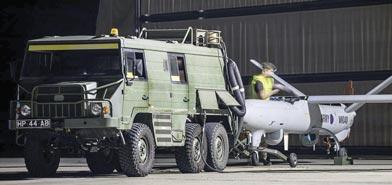
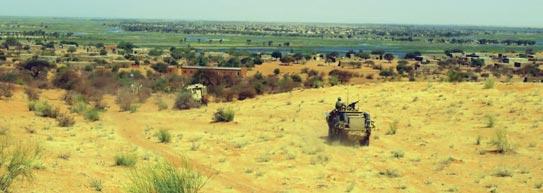
Protective Mobility (PM) vehicles on Operations
completing JAMES Component Reports and Form 10s. It is this information that justifies why changes are made. As a young tradesman (a few years ago now!), I didn’t appreciate the importance of passing this information to the Delivery Teams; it was about getting the job done well, however this is just as important and should be a reminder to all REME tradesman.
Joining VST and Ops Sp has given me stability and a good worklife balance while working with like-minded people; albeit not always wearing green kit. In addition, it gives an insight into the huge amount of opportunities DE&S has to offer for a further career within the MoD as a professional Engineer.
WO1 (ASM) Weekes – Technical Through Life Support (TTLS) to Future Fleets
Murray Reilly – Head of Technical Through Life Support (TTLS) to In-Service Fleets
Before joining DE&S, I served 26-years in REME and latterly 15-years as an Integrated Logistics Support Manager within the Defence Industry. From my experience the job is both fulfilling and rewarding, and allows me to contribute not only to the everyday Through Life Support needs within the Land Environment, but also ongoing Operation Requirements. My current role involves the management of my Technical Through Life Support (TTLS) In-Service Support Team, covering Wheeled and Tracked vehicles within DE&S; with added interests in the Logistic Support requirements of new equipments entering service.
For personnel considering a transition from front line unit Equipment Support to appointments at the heart of Defence Acquisition, or those considering leaving the Forces, DE&S is an ideal step forward when looking at alternative employers. Not only does DE&S provide a great work/life balance, but the organisation provides familiar equipments and working cultures. It is a chance to make a real difference, to use lessons and skill sets learnt to develop changes and challenge best practice within a team that matters and are vital to Operations. You don’t even have to leave Service now to join DE&S, you can transfer across under the new Military Transition Scheme initiatives.
AJAX
Currently serving in the REME and based at DE&S I have an insight into both Military and civilian aspects of Technical Through Life Support and Engineering, the benefits on offer and the work-life balance. From my experience I can honestly say that the job is both fulfilling and rewarding; continuing to contribute to the current Operational requirement without the “sometimes” disadvantages of everyday unit business enabling a constant focus and unwavering support to be offered. My current role involves bridging the gap between the demonstrating and manufacture phase of new platforms to transitioning into service, and the user. Engaging with units daily, resolving issues and managing all technical documentation relevant to platform portfolios.
Presently I am contributing to supporting the AJAX project; the next generation of Armoured Vehicles that are fully digital and integrated. The AJAX family consists of Ares, a troop-carrying reconnaissance vehicle, Ajax with a 40mm cannon, support variants Apollo and Atlas, a Command & Control variant Athena, and a Royal Engineer variant – Argus. This is a fleet of 589 medium-weight armoured vehicles to replace the existing Combat Vehicle Reconnaissance Tracked (CVR(T)) fleet, in addition to introducing new vehicle roles. Vehicles are being introduced in capability drops, with numbers and variants differing. How do we measure success? By providing a capability that is Fit, Form and Function, and supported throughout its In-service life, this is exactly what “we” Military and Civil Servant within MOD Abbeywood strive to achieve. Transitioning from front line unit Equipment Support, to appointments at the heart of Defence Acquisition would be an ideal step for someone who wants to support equipment that is familiar, vital to Operations and work for an employer that understands and encourages a good worklife balance.
